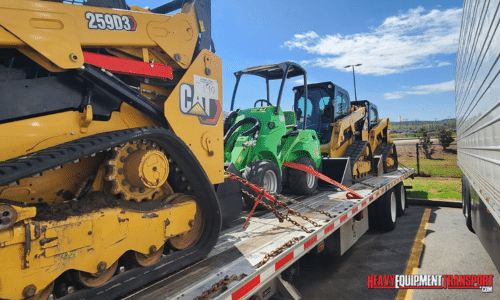The Role of Technology in Modern Heavy Equipment Transport

William Thomas / January 2021
Heavy equipment transport has been transformed by technological breakthroughs, which have replaced human muscle and simple tools with animal-drawn platforms and motorized vehicles. However, the sector witnessed a massive revolution with GPS tracking, automation, and sophisticated technology. These advancements have improved shipping efficiency, safety, and precision, transforming logistics. Heavy equipment transfer today entails streamlining the entire logistics process. In this blog article, we will look at the critical role of technology in modern heavy equipment transport and its far-reaching implications for the sector.
Connecting Heavy Equipment Shipping With The World

“The heavy equipment transport sector has been substantially altered by technological innovation. “
In the realm of heavy equipment transport, real-time data collection and processing are critical. They allow businesses to track and control shipments while on the go, ensuring seamless and efficient operations. It’s like watching a movie that catches every detail of your cargo rather than just a few photos. Consider the transformational power of 5G networks in this environment! 5G technology provides near-instant data transmission because of its high-speed and dependable connectivity. This means that transportation operations can run smoothly even in remote places. To summarize, 5G improves the mobility and reliability of transportation networks, pushing efficiency to new heights.

Transport Your Equipment Today
Heavy Equipment Transport is always available for a quote. Fill out the form or give us a call now! (888) 730-2951

How Automation Works in Oversize Load Shipping
The emergence of self-driving equipment is an excellent example of the continued trend toward automation in heavy machinery transportation. These self-driving machines can work without human interference, resulting in significant increases in efficiency, precision, and safety. Automation in heavy equipment transport increases efficiency and production in a variety of ways:
• Increased Productivity: Unlike humans, autonomous robots can operate 24 hours a day, seven days a week. As a result, output is more consistent, and downtime is reduced.
• Increased accuracy and Accuracy: Automated equipment can accomplish jobs with greater accuracy and consistency than people, minimizing the likelihood of errors and rework.
• Cost-Effective Operations: Automated machines reduce labor-related expenses such as pay, training, and benefits. Furthermore, they can decrease operational costs by reducing waste and increasing utilization rates.
• Increased Safety: By taking over dangerous jobs, autonomous machines reduce the chance of workplace accidents, improving overall safety and lowering accident and injury expenses.
Enhanced Safety for Equipment Shipping
In dangerous settings, automation technology eliminates the need for human operators, protecting them from potential mishaps and injury. Here’s how it’s done:
• Unmanned Operations: Automated machines conduct hazardous activities, reducing human exposure to risky situations.
• Sensors: These identify anomalies, impediments, and environmental conditions, activating safety measures as needed.
• Data Processing: Advanced algorithms analyze real-time sensor data to predict and mitigate threats.
• Predictive Maintenance: Machine wear and tear is detected by technology, prompting maintenance and preventing faults.
• Remote Monitoring: Operators can supervise automated operations from a safe distance, acting only when necessary.
• Emergency Stop Mechanisms: Automated systems feature fail-safes that stop operations during an unexpected incident, increasing safety.
Real-Time Equipment Shipping Decision Making
Technology advancements have altered real-time decision-making for site managers and crews. Telematics systems enable real-time data for fast decision-making based on site conditions, staff availability, and equipment status, allowing seamless communication. This integration improves operating efficiency and safety while increasing productivity and eliminating hazards. Telematics has become an indispensable tool in the industry.
The Future of Heavy Equipment Transport
Emerging technologies like artificial intelligence (AI) and the Internet of Things (IoT) have enormous promise to transform the heavy equipment transport business. AI can improve route selection, while IoT allows for improved vehicle tracking, lowering fuel usage and increasing safety. However, these developments have disadvantages, such as cybersecurity issues and expensive implementation costs. The industry may overcome these obstacles and fully capitalize on the benefits of technological breakthroughs by implementing robust security measures and properly arranging technology investments.
The heavy equipment transport sector has been substantially altered by technological innovation. It has increased operational efficiency and safety. We should expect even more improvement with new technologies like AI and IoT. These tools will not only make things faster and safer, but they will also demonstrate how the industry is expanding. The future of heavy equipment transportation is dependent on fully using these improvements.

William Thomas
Heavy Transport Specialist
Being able to lead a team of such talented logistics agents has been a wonderful experience over the past ten years. If you would like to know anything more about the heavy equipment transport services we offer, don't hesitate to give us a call!